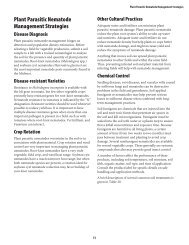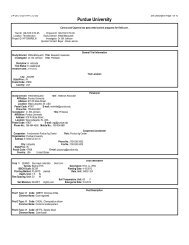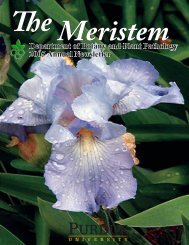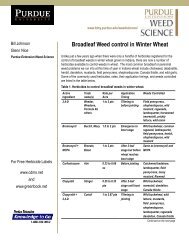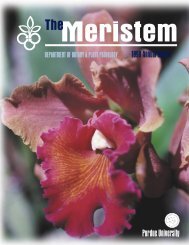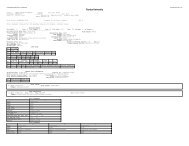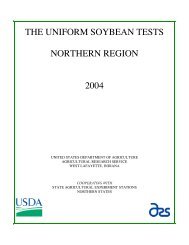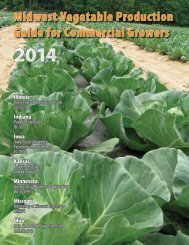- Page 1 and 2: THE UNIFORM SOYBEAN TESTS NORTHERN
- Page 3 and 4: 2009 UNIFORM SOYBEAN TESTS NORTHERN
- Page 5 and 6: 2009 UNIFORM TEST PARTICIPANTS Unif
- Page 7 and 8: 2009 UNIFORM TEST PARTICIPANTS Unif
- Page 9 and 10: Uniform Test Cooperator: Technical
- Page 11 and 12: STRAIN DESIGNATIONS Experimental (i
- Page 13: Seed Quality is rated according to
- Page 17 and 18: UNIFORM TEST STRAINS RELEASED IN 20
- Page 19 and 20: HG Type 0 (Race 3) HG Type 2.5.7 (R
- Page 21 and 22: Strain Parentage IDENTIFICATION OF
- Page 23 and 24: Strain Parentage IDENTIFICATION OF
- Page 25 and 26: Strain Parentage IDENTIFICATION OF
- Page 27 and 28: Strain Parentage IDENTIFICATION OF
- Page 29 and 30: Strain Parentage IDENTIFICATION OF
- Page 31 and 32: 2009 UNIFORM AND PRELIMINARY TEST L
- Page 33 and 34: Uniform Test 00, 2009 Seed Previous
- Page 35 and 36: UNIFORM TEST 00, 2009 REGIONAL SUMM
- Page 37 and 38: UNIFORM TEST 00, 2009 YIELD (bu/a)
- Page 39 and 40: UNIFORM TEST 00, 2009 MATURITY (dat
- Page 41 and 42: UNIFORM TEST 00, 2009 PLANT HEIGHT
- Page 43 and 44: UNIFORM TEST 00, 2009 SEED SIZE (g/
- Page 45 and 46: UNIFORM TEST 00, 2009 OIL (%) Mean
- Page 47 and 48: UNIFORM TEST 0, 2009 DESCRIPTIVE AN
- Page 49 and 50: UNIFORM TEST 0, 2009 YIELD (bu/a) M
- Page 51 and 52: UNIFORM TEST 0, 2009 MATURITY (date
- Page 53 and 54: UNIFORM TEST 0, 2009 PLANT HEIGHT (
- Page 55 and 56: UNIFORM TEST 0, 2009 SEED SIZE (g/1
- Page 57 and 58: UNIFORM TEST 0, 2009 OIL (%) Mean S
- Page 59 and 60: PRELIMINARY TEST 0, 2009 DESCRIPTIV
- Page 61 and 62: PRELIMINARY TEST 0, 2009 YIELD (bu/
- Page 63 and 64: PRELIMINARY TEST 0, 2009 MATURITY (
- Page 65 and 66:
PRELIMINARY TEST 0, 2009 PLANT HEIG
- Page 67 and 68:
PRELIMINARY TEST 0, 2009 SEED SIZE
- Page 69 and 70:
PRELIMINARY TEST 0, 2009 OIL (%) Me
- Page 71 and 72:
UNIFORM TEST I, 2009 DESCRIPTIVE AN
- Page 73 and 74:
UNIFORM TEST I, 2009 REGIONAL SUMMA
- Page 75 and 76:
UNIFORM TEST I, 2009 YIELD (bu/a) S
- Page 77 and 78:
UNIFORM TEST I, 2009 MATURITY (date
- Page 79 and 80:
UNIFORM TEST I, 2009 PLANT HEIGHT (
- Page 81 and 82:
UNIFORM TEST I, 2009 SEED SIZE (g/1
- Page 83 and 84:
Preliminary Test I, 2009 Seed Gen.
- Page 85 and 86:
PRELIMINARY TEST I, 2009 REGIONAL S
- Page 87 and 88:
PRELIMINARY TEST I, 2009 YIELD (bu/
- Page 89 and 90:
PRELIMINARY TEST I, 2009 YIELD RANK
- Page 91 and 92:
PRELIMINARY TEST I, 2009 MATURITY (
- Page 93 and 94:
PRELIMINARY TEST I, 2009 LODGING (s
- Page 95 and 96:
PRELIMINARY TEST I, 2009 PLANT HEIG
- Page 97 and 98:
PRELIMINARY TEST I, 2009 SEED QUALI
- Page 99 and 100:
PRELIMINARY TEST I, 2009 SEED SIZE
- Page 101 and 102:
PRELIMINARY TEST I, 2009 OIL (%) Me
- Page 103 and 104:
UNIFORM TEST II, 2009 DESCRIPTIVE A
- Page 105 and 106:
UNIFORM TEST II, 2009 REGIONAL SUMM
- Page 107 and 108:
UNIFORM TEST II, 2009 YIELD (bu/a)
- Page 109 and 110:
UNIFORM TEST II, 2009 YIELD RANK Wa
- Page 111 and 112:
UNIFORM TEST II, 2009 MATURITY (dat
- Page 113 and 114:
UNIFORM TEST II, 2009 LODGING (scor
- Page 115 and 116:
UNIFORM TEST II, 2009 PLANT HEIGHT
- Page 117 and 118:
UNIFORM TEST II, 2009 SEED QUALITY
- Page 119 and 120:
UNIFORM TEST II, 2009 SEED SIZE (g/
- Page 121 and 122:
UNIFORM TEST II, 2009 PROTEIN (%) L
- Page 123 and 124:
PRELIMINARY TEST IIA, 2009 DESCRIPT
- Page 125 and 126:
PRELIMINARY TEST IIA, 2009 YIELD (b
- Page 127 and 128:
PRELIMINARY TEST IIA, 2009 YIELD RA
- Page 129 and 130:
PRELIMINARY TEST IIA, 2009 MATURITY
- Page 131 and 132:
PRELIMINARY TEST IIA, 2009 LODGING
- Page 133 and 134:
PRELIMINARY TEST IIA, 2009 PLANT HE
- Page 135 and 136:
PRELIMINARY TEST IIA, 2009 SEED QUA
- Page 137 and 138:
PRELIMINARY TEST IIA, 2009 SEED SIZ
- Page 139 and 140:
PRELIMINARY TEST IIA, 2009 PROTEIN
- Page 141 and 142:
Preliminary Test IIB, 2009 Seed Gen
- Page 143 and 144:
PRELIMINARY TEST IIB, 2009 REGIONAL
- Page 145 and 146:
PRELIMINARY TEST IIB, 2009 YIELD (b
- Page 147 and 148:
PRELIMINARY TEST IIB, 2009 YIELD RA
- Page 149 and 150:
PRELIMINARY TEST IIB, 2009 MATURITY
- Page 151 and 152:
PRELIMINARY TEST IIB, 2009 LODGING
- Page 153 and 154:
PRELIMINARY TEST IIB, 2009 PLANT HE
- Page 155 and 156:
PRELIMINARY TEST IIB, 2009 SEED QUA
- Page 157 and 158:
PRELIMINARY TEST IIB, 2009 SEED SIZ
- Page 159 and 160:
PRELIMINARY TEST IIB, 2009 OIL (%)
- Page 161 and 162:
UNIFORM TEST III, 2009 DESCRIPTIVE
- Page 163 and 164:
UNIFORM TEST III, 2009 YIELD (bu/a)
- Page 165 and 166:
UNIFORM TEST III, 2009 YIELD RANK Y
- Page 167 and 168:
UNIFORM TEST III, 2009 MATURITY (da
- Page 169 and 170:
UNIFORM TEST III, 2009 LODGING (sco
- Page 171 and 172:
UNIFORM TEST III, 2009 PLANT HEIGHT
- Page 173 and 174:
UNIFORM TEST III, 2009 SEED QUALITY
- Page 175 and 176:
UNIFORM TEST III, 2009 SEED SIZE (g
- Page 177 and 178:
Mean 13 Carlisle Arthur Urbana Lafa
- Page 179 and 180:
UNIFORM TEST III, 2009 OIL (%) Mean
- Page 181 and 182:
Preliminary Test IIIA, 2009 Seed Ge
- Page 183 and 184:
PRELIMINARY TEST IIIA, 2009 REGIONA
- Page 185 and 186:
PRELIMINARY TEST IIIA, 2009 YIELD (
- Page 187 and 188:
PRELIMINARY TEST IIIA, 2009 YIELD R
- Page 189 and 190:
PRELIMINARY TEST IIIA, 2009 MATURIT
- Page 191 and 192:
PRELIMINARY TEST IIIA, 2009 LODGING
- Page 193 and 194:
PRELIMINARY TEST IIIA, 2009 PLANT H
- Page 195 and 196:
PRELIMINARY TEST IIIA, 2009 SEED QU
- Page 197 and 198:
PRELIMINARY TEST IIIA, 2009 SEED SI
- Page 199 and 200:
PRELIMINARY TEST IIIA, 2009 OIL (%)
- Page 201 and 202:
PRELIMINARY TEST IIIB, 2009 DESCRIP
- Page 203 and 204:
PRELIMINARY TEST IIIB, 2009 YIELD (
- Page 205 and 206:
PRELIMINARY TEST IIIB, 2009 YIELD R
- Page 207 and 208:
PRELIMINARY TEST IIIB, 2009 MATURIT
- Page 209 and 210:
PRELIMINARY TEST IIIB, 2009 LODGING
- Page 211 and 212:
PRELIMINARY TEST IIIB, 2009 PLANT H
- Page 213 and 214:
PRELIMINARY TEST IIIB, 2009 SEED QU
- Page 215 and 216:
PRELIMINARY TEST IIIB, 2009 SEED SI
- Page 217 and 218:
PRELIMINARY TEST IIIB, 2009 PROTEIN
- Page 219 and 220:
Uniform Test IV, 2009 Previous Gen.
- Page 221 and 222:
Plant Seed Seed Composition Yield R
- Page 223 and 224:
UNIFORM TEST IV, 2009 YIELD (bu/a)
- Page 225 and 226:
UNIFORM TEST IV, 2009 MATURITY (dat
- Page 227 and 228:
UNIFORM TEST IV, 2009 PLANT HEIGHT
- Page 229 and 230:
UNIFORM TEST IV, 2009 SEED SIZE (g/
- Page 231 and 232:
Preliminary Test IV, 2009 Gen. Uniq
- Page 233 and 234:
PRELIMINARY TEST IV, 2009 REGIONAL
- Page 235 and 236:
PRELIMINARY TEST IV, 2009 YIELD RAN
- Page 237 and 238:
PRELIMINARY TEST IV, 2009 LODGING (
- Page 239 and 240:
PRELIMINARY TEST IV, 2009 SEED QUAL
- Page 241 and 242:
PRELIMINARY TEST IV, 2009 PROTEIN (
- Page 243 and 244:
Uniform Test 0 Roundup-Ready, 2009
- Page 245 and 246:
UNIFORM TEST 0 Roundup-Ready, 2009
- Page 247 and 248:
UNIFORM TEST 0 Roundup-Ready, 2009
- Page 249 and 250:
UNIFORM TEST 0 Roundup-Ready, 2009
- Page 251 and 252:
Uniform Test I Roundup-Ready, 2009
- Page 253 and 254:
UNIFORM TEST I Roundup-Ready, 2009
- Page 255 and 256:
UNIFORM TEST I Roundup-Ready, 2009
- Page 257 and 258:
UNIFORM TEST I Roundup-Ready, 2009
- Page 259 and 260:
UNIFORM TEST I Roundup-Ready, 2009
- Page 261 and 262:
UNIFORM TEST I Roundup-Ready, 2009
- Page 263 and 264:
UNIFORM TEST I Roundup-Ready, 2009
- Page 265 and 266:
UNIFORM TEST I Roundup-Ready, 2009
- Page 267 and 268:
UNIFORM TEST I Roundup-Ready, 2009
- Page 269 and 270:
UNIFORM TEST I Roundup-Ready, 2009
- Page 271 and 272:
UNIFORM TEST II Roundup-Ready, 2009
- Page 273 and 274:
UNIFORM TEST II Roundup-Ready, 2009
- Page 275 and 276:
UNIFORM TEST II Roundup-Ready, 2009
- Page 277 and 278:
UNIFORM TEST II Roundup-Ready, 2009
- Page 279 and 280:
UNIFORM TEST II Roundup-Ready, 2009
- Page 281 and 282:
UNIFORM TEST II Roundup-Ready, 2009
- Page 283 and 284:
UNIFORM TEST II Roundup-Ready, 2009
- Page 285 and 286:
UNIFORM TEST II Roundup-Ready, 2009
- Page 287 and 288:
UNIFORM TEST II Roundup-Ready, 2009
- Page 289 and 290:
UNIFORM TEST II Roundup-Ready, 2009
- Page 291 and 292:
UNIFORM TEST III Roundup Ready, 200
- Page 293 and 294:
UNIFORM TEST III Roundup-Ready, 200
- Page 295 and 296:
UNIFORM TEST III Roundup-Ready, 200
- Page 297 and 298:
UNIFORM TEST III Roundup-Ready, 200
- Page 299 and 300:
UNIFORM TEST III Roundup-Ready, 200
- Page 301 and 302:
UNIFORM TEST III Roundup-Ready, 200
- Page 303 and 304:
UNIFORM TEST III Roundup-Ready, 200
- Page 305 and 306:
UNIFORM TEST III Roundup-Ready, 200
- Page 307 and 308:
UNIFORM TEST III Roundup-Ready, 200




